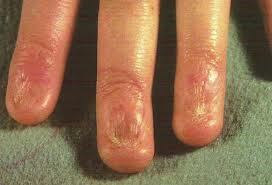Anonychia. It is characterized by nail abnormalities ranging from onychodystrophy (dystrophic nails) to anonychia (absence of nails). Onychodystrophy-anonychia has been described in at least four generations of a family with male-to-male transmission, suggesting an autosomal dominant inheritance. Anonychia has been described in less than 20 cases; it is likely to be transmitted as an autosomal recessive trait. Congenital total anonychia, in which the individual lacks all fingernails and toenails, may have an autosomal dominant inheritance pattern. Anonychia is manifested by the absence of a part or all of one or more nails. Various forms of hyperkeratosis arising from the residual matrix and the nail bed indicate permanent anonychia, Temporary anonychia can result from onychomadesis associated with transient local or systemic disorders. In case of being local, the appearance of the nail can guide us towards the etiological process. In the congenital forms of anonychia, we can find radiological abnormalities in the underlying bone. Toxic interactions during organogenesis, metabolic disorders analogous to anagen effluvia, severe abnormal epidermal scarring damaging the nail matrix. When a person manifests the absence of part or all of one or more fingernails, this condition is technically called Anonychia. This can occur due to simple trauma, infections or diseases that have these genetic causes. This nail disorder is extremely rare.


Variants
- Congenital anonychia
- Anonychia acquired
Associations
- Idiopathia
- Hypoplasia
- Metabolic disorders
- Onychomadesis
- Lichen planus
Clinic
- Physical exploration
- Radiological studies
Types of disease
There are three types of this disease:
- Combined: there are isolated cases of with facial dysmorphology, in particular with deformation of the nose.
- Total congenital: It is a rare disorder in which all the fingernails and toenails are absent without significant bone abnormalities. It has an autosomal dominant inheritance pattern.
- Acquired: it is the result of the total or partial destruction of the nail hue due to inflammatory disorders or trauma.
Physical characteristics
Affected individuals who generally suffer from it have certain physical characteristics:
- They have no hair
- They present loss of teeth
- Have bone abnormalities
Similar conditions
Similarly, there are a variety of syndromes or conditions associated with Congenital Anonychia that can include nail loss as a symptom. For example:
- Deafness
- Onychodystrophy
- Osteodystrophy
- Mental retardation syndrome
This syndrome, in which the four previous conditions are present, the signs and symptoms are variable, even among affected members of the same family. This diagnosis is similar to others such as:
- Iso Kikuchi syndrome: can affect the nails of those who suffer from the disease. Typically a patient may not have developed fingernails on the index, thumb, or middle fingers. You can also lose them over time
- Ellis-vanCreveld syndrome: It is another genetic disease that can cause missing toenails. This syndrome mainly affects the body bones, which in turn affects the growth of the nails.
- Nail-patella syndrome: It is a hereditary bone condition that can result in the disappearance of bones and nails of the patella.
- Epidermolysis bullosa: the main symptom is fragile skin, mainly causing the loss of nails through shedding of the skin.
Causes
It is believed to be caused by mutations in the RSPO4 gene and inherited in an autosomal recessive manner. Until the latest investigations of the most striking case involving a German family with four affected brothers and five not, this is the first gene responsible for a nail disorder. Generally, medical professionals use the term for congenital diseases, which occur when a baby is formed abnormally. Similarly, nail lesions are associated with erythematous scaly lesions of the lymph nodes. Although the term may not be necessary, this diagnosis can also occur under:
- Traumatic injuries
- Radiological abnormalities in the bone
- Severe abnormal epidermal scarring
- Toxic interactions
- Fungal infections that alter the environment under the nail to the point of eliminating it
- Inflammation in the nails
- Delicate conditions in the upper and lower extremities
- Severe trauma
- Surgery
- Burns
- Freezing
Diagnosis
Sometimes there is often a misdiagnosis. According to the symptom of muscle spasms in the legs, mainly at night, confusion arises in the specialist, however with a series of tests it is quickly determined that it is a classic sign of undefined diabetes. Testing for a genetic disease like this can be a real challenge. Health professionals usually thoroughly review:
- Medical history of a person
- Symptoms
- Lab test results
Similarly, a physical examination of the shape, contour, brightness, color, translucency, consistency, structure, and level of deformity may be included. All this to get the origin of this problem.
Symptoms
It is a feature of functional and dermolytic epidermolysis bullosa. It is usually associated with skin blisters, erosions, and granulomatous tissue. The list of symptoms present includes very few signs, however the most frequent are listed below:
- No nails on the hands or feet
- Dry Skin
- Total loss of any trace of a fingernail
- Hyperpigmentation in the groin or armpit
- Sharp fabrics including fur
- Hypopigmentation in groin or armpit
- Nail atrophy
Treatment
Living with a genetic disease can affect the daily lives of patients and their families. Non-surgical options can include artificial nail prostheses, however this option can become uncomfortable due to the reduction of sensitivity in the affected areas. On the other hand, surgical options for the upper extremities may include nail matrix grafts belonging to the toes, in the case of having them. Remember that only the treating physician can advise whether any of these methods is appropriate for your specific medical condition. Try to discuss all treatment options with him before making a decision, especially whether to start or stop a specific treatment plan.
